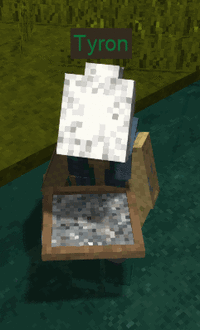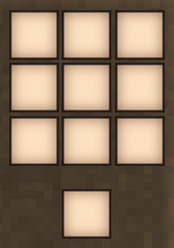Panning/es: Difference between revisions
(Created page with "El '''Bateo''' es un método para obtener pepitas de metal de la arena y la grava. Es especialmente útil al principio del juego, ya que ofrece una alternativa segura y fiable a buscar pepitas perdidas en la superficie, y también puede proporcionar otros recursos útiles.") |
(Created page with "== Requerimientos ==") |
||
| Line 8: | Line 8: | ||
__TOC__ | __TOC__ | ||
== | == Requerimientos == | ||
Players may pan [[gravel]], [[sand]] or [[bony soil]] blocks. Gravel and sand can be found on the surface, while bony soil is found around or under ruins. Each block can be panned eight times. Different types of blocks may result in slightly different drops. Bony soil in particular uses a different drop table, meaning that panning bony soil may give players items that they cannot get from panning gravel or soil. Panning bony soil may drop very helpful items for early-game players. | Players may pan [[gravel]], [[sand]] or [[bony soil]] blocks. Gravel and sand can be found on the surface, while bony soil is found around or under ruins. Each block can be panned eight times. Different types of blocks may result in slightly different drops. Bony soil in particular uses a different drop table, meaning that panning bony soil may give players items that they cannot get from panning gravel or soil. Panning bony soil may drop very helpful items for early-game players. | ||
Revision as of 14:05, 28 February 2023
El Bateo es un método para obtener pepitas de metal de la arena y la grava. Es especialmente útil al principio del juego, ya que ofrece una alternativa segura y fiable a buscar pepitas perdidas en la superficie, y también puede proporcionar otros recursos útiles.
Requerimientos
Players may pan gravel, sand or bony soil blocks. Gravel and sand can be found on the surface, while bony soil is found around or under ruins. Each block can be panned eight times. Different types of blocks may result in slightly different drops. Bony soil in particular uses a different drop table, meaning that panning bony soil may give players items that they cannot get from panning gravel or soil. Panning bony soil may drop very helpful items for early-game players.
- Note: Even though Muddy Gravel has the word "gravel" in its name, it cannot be panned.
 The primary tool used in panning is the wooden pan. This is created by crafting one log with a knife in the crafting grid.
The primary tool used in panning is the wooden pan. This is created by crafting one log with a knife in the crafting grid.
Process
In order to pan a block, players must perform the following steps:
- Place the pan in the hotbar and equip it in the active hand.
- Place the block to be panned (the "target block") on dry land, not touching water.
Fill the pan while aiming the crosshairs at the target block.
- Stand in water.
Wash the pan while standing in water and wait until the pan is empty.
Any items recovered from the process will transfer to the player's hotbar or inventory. Items that do not fit in the player's inventory will drop to the ground at the player's feet.
During the entire panning process, players can remain standing in water. This is the most efficient setup, since the target blocks can just be placed at the edge of the water. Partially-panned blocks that are touching water will be instantly destroyed, so players should avoid panning blocks that are directly touching water.
Results
Panning produces several types of useful small items, as well as rarer yields such as decorative headgear and lore items. It can also provide parts for early weapons.
Common resource drops from panning include loose stones (corresponding to the local rock layer), flint, ore nuggets for copper, sphalerite, cassiterite and gold, quartz chunks (clear or regular) and blue clay.
Common items from panning include flint and copper arrowheads or spearheads, metal scraps (which can be used to create scrap weapon kits), and rusty gears.
Additionally, panning may give players lore items such as books, or decorative clothing such as diadems and necklaces. These can be sold to traders for more rusty gears.
In addition to all of the following, panning bony soil can also give bones, silver nuggets, and candles. More rarely, panning bony soil can also give components for armor such as tin bronze or copper chain and lamellae.
Panning drops
These drops are listed in rough order of probability, with the most common drops at the top and the rarest drops at the bottom.
Gravel or sand
- Loose stone (layer specific)
- Nugget, native copper
- Flint
- Blue clay
- Quartz chunk
- Nugget, sphalerite
- Flint arrowhead
- Copper arrowhead
- Flint spearhead
- Clear quartz
- Copper spearhead
- Rusty gears
- Nugget, native gold
- Nugget, cassiterite
- Rough lapis lazuli
- Metal parts
- Metal scraps
- Bronze armlet
- Bony ribcage
- Temporal gear
- Resonance archive (Cultured Tavern)
- Resonance archive (Quirky Tavern)
- Golden necklace
- Bronze gem necklace
- Silver chain
- Silver diadem
- Gold coronet
Bony soil
- Bone
- Flax fibers
- Flint arrowhead
- Copper arrowhead
- Rusty gears
- Bony ribcage
- Candle
- Rough emerald
- Rough peridot
- Rough diamond
- Nugget, native gold
- Nugget, native silver
- Copper spearhead
- Lore book (Tobias)
- Lore book (Research)
- Lore book (Diaries)
- Lore book (Jonas)
- Temporal gear
- Lamellae (Copper)
- Lamellae (Tin Bronze)
- Metal Chain (Copper)
- Metal Chain (Tin Bronze)
- Metal Scales (Tin Bronze)
- Resonance archive (Cultured Tavern)
- Resonance archive (Quirky Tavern)
- Golden necklace
- Bronze gem necklace
- Bronze armlet
- Silver chain
- Silver diadem
- Gold coronet
Video Tutorials
This panning tutorial was made for version 1.13, but is still relevant for version 1.17.
| Ores, metals and minerals | |
|---|---|
| Guides | Ore Deposits • Metals |
| Metals | Copper • Iron • Meteoric iron • Gold • Silver • Lead • Tin • Zinc • Bismuth • Titanium (Ilmenite) |
| Alloys | Bronze (Tin bronze, bismuth bronze, black bronze) • Steel • Brass • Solder (Lead solder, Silver solder) • Molybdochalkos • Cupronickel • Electrum |
| Minerals | Alum • Borax • Cinnabar • Coal • Halite (Salt) • Lapis lazuli • Quartz • Saltpeter • Sulfur • Sylvite (Potash) |
| Tools | Pickaxe • Hammer • Prospecting Pick • Crucible • Forge • Ore blasting bomb • Quern • Anvil • Bloomery • Helve hammer • Pulverizer |
| Other | Gemstones |
| Related mechanics | Panning • Mining • Clay forming • Casting • Smithing • Steel making |
| Wiki Navigation | |
|---|---|
| Vintage Story | Guías • Preguntas más frecuentes (FAQ) • Vintage Story Original Soundtrack • Versiones • Controles |
| Mecánicas de juego | Fabricación • Talla Lítica • Alfarería • Herrería • Cocina • Temperatura • Hambre • Minería • Estabilidad temporal • Energía mecánica • Comercio • Agricultura • Ganadería |
| Mundo | Generación del Mundo • Biomas • Clima • Tormentas temporales |
| Objetos | Herramientas • Armas • Armadura • Ropa • Mochilas • Materiales • Comida |
| Bloques | Terreno • Plantas • Decorativo • Iluminación • Functional • Minerales |
| Entidades | Entidades hostiles • Animales • NPCs • Jugadores |
| Miscellaneous | List of client commands • Lista de comandos del servidor • Guia de iniciación de Modo creativo • Bot System • Cómo utilizar Worldedit • Cinematic Camera • Adjustable FPS Video Recording • ServerBlockTicking |

